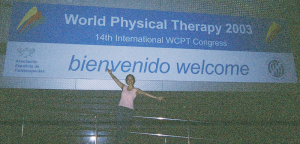"Living with a chronic pain condition can make you question whether its possible for you to get better, to go back to activities you love. Suparna's approach presupposes that you will make a full recovery, using activity instead of rest. To feel like a normal active person instead of a rare case of an obscure and incurable ailment is already a powerful first step; and the rest of the program fulfills this promise."
About Suparna
Suparna Damany is a trained physical therapist with over 25 years of experience. For the last 17 years, she has specialized in the treatment of chronic pain, repetitive stress injuries and myofascial pain. Suparna treats patients from all over the world at her clinic in Allentown, Pennsylvania.

She received her Bachelor’s degree in Physical Therapy from Bombay University, India, and her Master’s degree in Physical Therapy from Temple University, Philadelphia. She is a Certified Hand Therapist and a Certified Ergonomics Assessment Therapist. Her diverse education has given her a strong clinical background to understand the causes of pain and develop specialized treatment techniques. She is the co-author of the book, “It’s Not Carpal Tunnel Syndrome”, which is a landmark book on the subject of Repetitive Stress Injuries.
Honing her knowledge and techniques over her years of experience dealing with chronic symptoms and injuries, Suparna developed a program that everyone can access – in the comfort of their own home or office. This program has been tested and proven effective, and now is offered to anyone who is determined to live an ache-free life.
Contributing to a healthier, happier society and helping people meet their goals to do what they love most, is what drives Suparna. She believes that the human body has an amazing capacity to heal. In fact, she says, the two things that the human body does best are healing and – if the body cannot find a way to heal – compensating! Her theory is that with any long-standing condition or symptomatology, the body adapts to allow function, and therefore, in any chronic condition, there are several body parts and physiological processes involved. In a way, the body forgets what “normal” and “pain-free” is, and modifies itself to best allow functioning. For example, if there is an injury to the lower back for a sustained period of time, the spine (which is a column) adapts and starts recruiting other areas (i.e., the mid back and the neck) to manage the low back weakness.  Thus, it is not uncommon for low back pain to spread to the neck and vice versa. Similarly, one could have hip and knee pain with low back pain or foot pain, and neck as well as shoulder blade symptoms could cause jaw pain and chest pain. Even though the body is doing the best it can to protect the sufferer, the mechanisms it uses are meant for short-term symptoms; in the long-term, these changes are counter-productive to recovery. In order to allow the body to heal completely and permanently, it is important not only to focus on the injured area but to take a holistic view to the symptoms – to identify the cause(s) and restore health, not just “Band-Aid” fix the problem. It’s just a matter of nudging the body in the correct direction and addressing all the pieces of the puzzle that make up the chronic pain syndrome…and the body does the rest! Suparna explains that she makes it her job to nudge the injured body in the right direction to help it on the path to healing itself. “Watching the human body and mind recover from chronic pain / injuries is like watching a miracle unfold; I witness this miracle every day.”
Thus, it is not uncommon for low back pain to spread to the neck and vice versa. Similarly, one could have hip and knee pain with low back pain or foot pain, and neck as well as shoulder blade symptoms could cause jaw pain and chest pain. Even though the body is doing the best it can to protect the sufferer, the mechanisms it uses are meant for short-term symptoms; in the long-term, these changes are counter-productive to recovery. In order to allow the body to heal completely and permanently, it is important not only to focus on the injured area but to take a holistic view to the symptoms – to identify the cause(s) and restore health, not just “Band-Aid” fix the problem. It’s just a matter of nudging the body in the correct direction and addressing all the pieces of the puzzle that make up the chronic pain syndrome…and the body does the rest! Suparna explains that she makes it her job to nudge the injured body in the right direction to help it on the path to healing itself. “Watching the human body and mind recover from chronic pain / injuries is like watching a miracle unfold; I witness this miracle every day.”
Suparna’s long standing ‘wellness mantra’ is: Aging is inevitable but suffering is not.
Suparna encourages everyone to be responsible for their own health – a passive, quick fix approach does not work. “Respect your health and listen to your body. Take a moment before any activity to figure out the best way to complete it so that it is the most efficient and safe for you. Nowadays, we use our bodies in ways that we were not built for. In order to stay healthy, we have to learn to be kind to our bodies. It’s a simple damage and repair scale. We constantly do things to damage our bodies but to counter that, we have to put in at least an equal effort to make sure we don’t cause injuries. If we are kinder to our body than we are abusive, we build a cushion which allows us to occasionally ‘overdo’ things and still remain healthy. Even if you cannot see the consequences of your actions immediately, what you do today affects how you will feel in the future, because daily, seemingly routine actions add up. Think long term, learn to respect your body and live a fit and pain – free life.”

